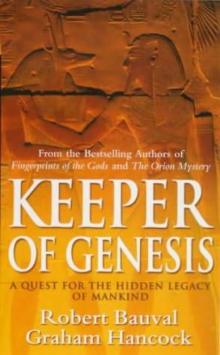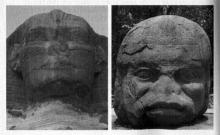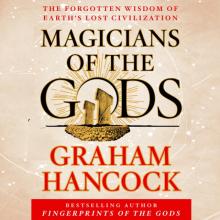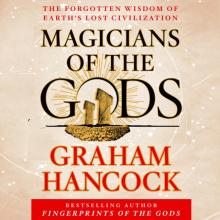- Home
- Graham Hancock
The Message of the Sphinx AKA Keeper of Genesis Page 2
The Message of the Sphinx AKA Keeper of Genesis Read online
Page 2
Often sand engulfed it. At widely separated intervals a benevolent ruler would arrange to have it cleared. There were those who attempted to restore it, covering parts of its rock-hewn body with blocks of masonry. For a long period it was painted red.
By Islamic times the desert had buried it up to its neck and it had been given a new, or perhaps a very old, name: ‘Near to one of the Pyramids,’ reported Abdel-Latif in the twelfth century, ‘is a colossal head emerging from the ground. It is called Abul-Hol.’ And in the fourteenth century El-Makrizi wrote of a man named Saim-ed-Dahr who ‘wanted to remedy some of the religious errors and he went to the Pyramids and disfigured the face of Abul-Hol, which has remained in that state from that time until now. From the time of this disfigurement, also, the sand has invaded the cultivated land of Giza, and the people attribute this to the disfigurement of Abul-Hol.’
1. Profile of the Great Sphinx from the south showing restoration blocks along the paws and flanks and extensive weathering on the core limestone body.
Enduring memories
Abul-Hol, the Arabic name for the Great Sphinx of Egypt, is supposed by most translators to mean ‘Father of Terror’.
An alternative etymology, however, has been proposed by the Egyptologist Selim Hassan. During the extensive excavations that he undertook on the Giza plateau in the 1930s and ‘40s he uncovered evidence that a colony of foreigners—‘Cananites’—had resided in this part of Lower Egypt in the early second millennium bc. They were from the sacred city of Harran (located in the south of modern Turkey near its border with Syria) and they may perhaps have been pilgrims. At any rate artefacts and commemorative stelae prove that they lived in the immediate vicinity of the Sphinx—worshipping it as a god under the name Hwl.[1]
In the Ancient Egyptian language, bw means ‘place’. Hassan therefore reasonably proposes that Abul-Hol, ‘is simply a corruption of bw Hwl, “the Place of Hwl”, and does not at all mean “Father of Terror”, as is generally supposed’.[2]
When speaking of the Sphinx, the Ancient Egyptians frequently made use of the Harranian derivation Hwl, but they also knew it by many other names: Hu,[3] for example, and Hor-em-Akhet—which means ‘Horus in the Horizon’.[4] In addition, for reasons that have never been fully understood, the Sphinx was often referred to as Seshep-ankh Atum, ‘the living image of Atum,[5] after Atum-Re the self-created sun-god, the first and original deity of the ancient Egyptian pantheon. Indeed, the very name ‘Sphinx’ that has haunted the collective subconscious of the Western world since Classical times, turns out to be no more than a corruption—through Greek—of Sheshep-ankh.
In this way, with subtlety, a number of very archaic ideas, once held by the ancient Egyptians, have survived for thousands of years.[6] Would we not be foolish, therefore, to ignore entirely the lingering tradition that associates the Sphinx with a great and terrible riddle?
Stillness and silence
Crouching in the massive horseshoe-shaped trench of bedrock out of which it was carved, the statue looks old: a fierce and raddled towering monster, higher than a six-storey building and as long as a city block. Its flanks are lean, deeply scalloped by erosion. Its paws, now covered with modern repair bricks, are substantially worn away. Its neck has been clumsily shorn up with a cement collar intended to keep its grizzled head in place. Its face, too, is bruised and battered, and yet it somehow seems serene and ageless, unpredictably portraying different moods and expressions at different times and seasons, coming alive with patterns of light and shadow cast by scudding clouds at dawn.
Wearing the elegant nemes head-dress of an Egyptian Pharaoh, it gazes patiently into the east, as though waiting for something—waiting and watching, lost in its ‘stillness and silence’ (in the words of the Roman naturalist Pliny), and targeting for ever the equinoctial rising point of the sun.
How long has it stood here inspecting the horizon?
Whose image does it portray?
What is its function?
In our search for answers to these questions we have found ourselves drawn into strange and unexpected areas of research. Like souls on the way of the dead, we have had to pass through the dark kingdom of the ancient Egyptian afterworld, to navigate its narrow corridors, flooded passageways and hidden chambers, and to confront the fiends and demons lurking there. Using computer simulations we have journeyed back in time to stand beneath skies more than 12,000 years old, and watched Orion cross the meridian at dawn as Leo rose resplendent in the east. We have immersed ourselves in archaic rebirth texts and myths and scriptures and found amongst them the veiled remnants of a remarkable ‘astronomical language’ that can, without too much difficulty, be read and understood today.
Through clues expressed in this language we believe that we are able to identify with certainty who and what the Sphinx really is. Moreover, as we shall see in Parts III and IV, this identification appears to open a window on a forgotten episode in human history when the waters of a great deluge were ebbing and men sought to transform themselves into gods. In our opinion the stakes are high. Indeed we think it possible that the Sphinx and the three great Pyramids may offer knowledge of the genesis of civilization itself. Our immediate aim in Parts I and II, therefore, is to undertake a complete re-evaluation of all these titanic monuments, of the scholarship that has surrounded them during the past century or so, and of their numerous neglected, geodetic and geological and astronomical qualities.
Once these factors are taken into account a new Rosetta Stone begins to emerge, expressed in architecture and time, in allegories and symbols, and in specific astronomical directions and co-ordinates that tell the seeker where to look and what he might hope to find.
Meanwhile the Great Sphinx waits patiently.
Keeper of secrets.
Guardian of mysteries.
Chapter 2
The Riddle of the Sphinx
‘Sphinx, mythological creature with a lion’s body and human head ... The earliest and most famous example in art is the colossal recumbent Sphinx at Giza, Egypt, dating from the reign of King Khafre (4th dynasty, c.2575-2465 bc). This is known to be a portrait statue of the King ...’
Encyclopaedia Britannica
There is a belief that the Great Sphinx of Giza was fashioned during that period of Egyptian history classified as the ‘Old Kingdom’ on the orders of the Fourth Dynasty Pharaoh named Khafre whom the Greeks later knew as Chephren and who reigned from 2520-2494 bc. This is the orthodox historical view and readers will find it reported in all standard Egyptological texts, in all encyclopaedias, in archaeological journals and in popular scientific literature. In these same sources it is also repeatedly stated as fact that the features of the Sphinx were carved to represent Khafre himself—in other words, its face is his face.
Thus, for example, Dr. I. E. S. Edwards, a world-renowned expert on the monuments of the Giza necropolis, tells us that although the face of the Sphinx has been ‘severely mutilated’: ‘it still gives the impression of being a portrait of Khafre and not merely a formalised representation of the king.’[7]
In a similar vein Ahmed Fakhry, professor of ancient history at Cairo University, informs us that: ‘as it was first conceived, the Sphinx symbolised the king, and its face was carved in Khafre’s likeness.’[8]
The only problem—at any rate without access to a time machine—is that none of us, not even distinguished Egyptologists, is really in a position to say whether or not the Sphinx is a portrait or likeness of Khafre. Since the Pharaoh’s body has never been found we have nothing to go on except surviving statues (which might or might not have closely resembled the king himself). The best known of these statues, an almost unsurpassable masterpiece of the sculptor’s art carved out of a single piece of black diorite, now reposes in one of the ground-floor rooms of the Cairo Museum. It is to this beautiful and majestic representation that the scholars make reference when they tell us—with such confidence—that the Sphinx was fashioned in Khafre’s likeness.
This
confidence was particularly apparent in an article in the prestigious National Geographic magazine which appeared in the US in April 1991, and a similar one that appeared in Britain in the Cambridge Archaeological Journal in April 1992.[9] The articles were written by Professor Mark Lehner, of Chicago University’s Oriental Institute, who used ‘photogrammetric data and computer graphics’ to ‘prove’ that the face of the great Sphinx was that of Khafre:
Zahi Hawass, Director General of the Giza Pyramids, invited me to join his excavation [around the Sphinx] in 1978. During the next four years I led a project to map the Sphinx in detail for the first time. We produced front and side views with photogrammetry, a technique using stereoscopic photography ... Computers have taken the records further. Maps were digitized to make a 3-D wireframe model; some 2.6 million surface points were plotted to put ‘skin’ on the skeleton view. We have constructed images of the Sphinx as it may have looked thousands of years ago. To create the face, I tried matching views of other sphinxes and pharaohs to our model. With the face of Khafre, the Sphinx came alive ...[10]
It all sounds technically very impressive and persuasive. After all, who in their right mind is going to argue with ‘2.6 million surface points’ based on ‘stereoscopic photography’ and ‘photogrammetry’?
Behind the technical jargon, however, the truth is rather less awe-inspiring. A close reading shows that all that Lehner did in order to ‘reconstruct’ the face of the Sphinx was to prepare a computerized three-dimensional wireframe skeleton on which he then superimposed the face of Khafre. This is admitted in the National Geographic article, which reproduces a photograph of the diorite statue of Khafre above the following caption: ‘The author [Lehner] used this face for the computer reconstruction of the Sphinx.’[11]
So what Mark Lehner really did was to remodel the face of the Sphinx on a computer according to his own preferences—in much the same way that some ancient Egyptians had probably done several times before him on the face of the statue itself. The present features of the Sphinx, in other words, are no more likely to be those of Khafre than they are to be those of a number of other Pharaohs—Thutmosis IV, for example, or Amenhotep, or Ramesses II (who is last known, as Lehner admits, to have ‘extensively reworked’ the monument at around 1279 bc).[12] The simple, honest truth is that during the thousands of years of the Sphinx’s existence, often with only its head protruding above the sand, almost anyone could have worked on its face at almost any time. Moreover, Lehner’s own photogrammetric study has thrown up at least one piece of evidence which is highly suggestive of major recarving: the Sphinx’s head, he writes, is ‘too small’ in proportion to the body. He tells us that this is because it is an early prototype of the later very popular (and always proportionate) sphinx form, and speculates that ‘the Fourth Dynasty Egyptians may not [yet] have worked out the canon of proportions between the royal head with the nemes headdress on the lion body’.[13] He does not consider the equally valid and more intriguing possibility that the head was once much larger—and perhaps even leonine, and that it was reduced in size by recarving.
Probably relevant in this regard is an additional observation that Lehner has made: ‘a subtle discrepancy’ exists ‘between the axis of the head [of the Sphinx] and that of the facial features’[14]—the head being orientated perfectly to due east, and the features swivelled somewhat to the north of east.
Once again this is an error that is consistent with the recarving of a much older and heavily eroded statue. And it is consistent, too, as we shall see later in this chapter, with new geological evidence concerning the Sphinx’s antiquity. Setting these matters aside for the moment, however, it seems clear that the mere fact that Mark Lehner is able to graft an image of Khafre onto the battered visage of the Sphinx by means of the ‘ARL (Advanced Research Logic) Computer and the AutoCAD (release 10) graphics application’,[15] proves nothing more than that with good computer graphics you can make anyone’s face look like anyone else’s face. ‘The same computer technique,’ in the words of one outspoken critic, ‘could be used to “prove” the Sphinx was really Elvis Presley ...’[16]
It was partly in an attempt to resolve this impasse that a group of independent researchers took the unusual step of bringing a detective to Egypt in 1993. The detective in question was Lieutenant Frank Domingo, a senior forensic artist with the New York Police Department, who has been preparing ‘identikit’ portraits of suspects for more than twenty years. As a man who knows and works with faces every day of his professional life, he was commissioned to make a detailed study of the points of similarity and difference between the Sphinx and the Khafre statue. Months later, after returning to his lab in New York where he undertook careful comparisons of hundreds of photographs of the two works, Domingo reported:
After reviewing my various drawings, schematics and measurements, my final conclusion concurs with my initial reaction, i.e. that the two works represent two separate individuals. The proportions in the frontal view, and especially the angles and facial protrusion in the lateral views convinced me that the Sphinx is not Khafre ...’[17]
So on the one hand we have a top forsenic expert, Frank Domingo, telling us that the Sphinx’s face does not represent Khafre’s face. And on the other we have Mark Lehner, the Egyptologist computer buff, saying that only with Khafre’s face does the Sphinx ‘come alive’.
Undatable, anonymous
Why is there room for such widely varying opinions concerning the world’s best known and most intensively studied ancient monument?
In 1992, in two different forums, Mark Lehner made somewhat contradictory statements which hint at the answer to this question:
1. At the annual meeting of the American Association for the Advancement of Science he said: ‘There is no direct way to date the Sphinx itself because the Sphinx is carved right out of natural rock.’[18]
2. In the Cambridge Archaeological Journal he wrote: ‘Although we are certain that the Sphinx dates to the Fourth Dynasty, we are confronted by a complete absence of Old Kingdom texts which mention it.’[19]
To deal with the first point first, it is a simple matter of fact that no objective test presently exists for the accurate dating of rock-hewn monuments.[20] Many people are under the erroneous impression that the radio-carbon technique could be used, but this is not so: it is only applicable to organic materials (in which it measures the quantity of the isotope Carbon-14 that has decayed since the death of the organism in question). Since the Sphinx is made of carved rock it cannot be dated by this method.
This brings us to the second point. Stone monuments can be dated with reasonable accuracy if there are contemporary texts which refer to their construction. Ideally, in the case of the Sphinx, what one would require would be an inscription carved during the Fourth Dynasty and directly attributing the monument to Khafre. As Mark Lehner admits, however, no contemporary text referring to the Sphinx has ever been found.
In all honesty, therefore, what confronts us at Giza is an entirely anonymous monument, carved out of undatable rock, about which, as the forthright Egyptologist Selim Hassan wrote in 1949, ‘no definite facts are known’.[21]
One syllable
Why, therefore, do Mark Lehner and other influential modern scholars continue to link the Sphinx to Khafre and to insist that ‘The Old Kingdom Fourth Dynasty date for [its] origin ... is no longer an issue’[22]?
One reason is a single syllable carved on the granite stela which stands between the monument’s front paws and which has been taken as proof that Khafre built the Sphinx. The stela, which is not contemporary with the Sphinx itself, commemorates heroic efforts by the Pharaoh Thutmosis IV (1401-1391 bc) to clear the Sphinx completely of encroaching sand and describes the lion-bodied statue as the embodiment of ‘a great magical power that existed in this place from the beginning of all time’.[23] The inscription also contains, in line 13, the first syllable—Khaf—of the name Khafre. The presence of that syllable, in the words of Sir E. A. Wallis Budge,
is: ‘very important for it proves that ... the priests of Heliopolis who advised Thutmosis to undertake the work of clearing away the sand from the Sphinx believed that it was fashioned by Khafre ...’[24]
But does the syllable Khaf really prove so much?
When the stela was excavated by the Genoese adventurer Gian Battista Caviglia in 1817, line 13—which has now entirely flaked away—was already badly damaged. We know of its existence because, not long after the excavation, the British philologist Thomas Young, a leading expert in the decipherment of ancient Egyptian hieroglyphs, was able to make a facsimile of the inscription. For line 13 his translation reads as follows: ‘... which we bring for him: oxen ... and all young vegetables; and we shall give praise to Wenofer ... Khaf ... the statue made for Atum-Hor-em-Akhet. ...’[25]
On the assumption that Khaf was Khafre’s name, Young added the syllable Re between square brackets to show that a lacuna had been filled in.[26] In 1905, however, when the American Egyptologist James Henry Breasted studied Young’s facsimile he concluded that a mistake had been made: ‘This mention of King Khafre has been understood to indicate that the Sphinx was the work of this king—a conclusion which does not follow; [the facsimile of] Young has no trace of a cartouche ...’[27]
In all the inscriptions of ancient Egypt, from the beginning to the end of Pharaonic civilization, the names of kings were always inscribed inside oval-shaped signs or enclosures known as ‘cartouches’. It is therefore extremely difficult to understand how on the granite stela between the paws of the Sphinx the name of as powerful a king as Khafre—or indeed of any other king—could have been written without its pre-required cartouche.

 Underworld: The Mysterious Origins of Civilization
Underworld: The Mysterious Origins of Civilization The Master Game: Unmasking the Secret Rulers of the World
The Master Game: Unmasking the Secret Rulers of the World America Before
America Before Entangled
Entangled War God: Nights of the Witch
War God: Nights of the Witch War God: Return of the Plumed Serpent
War God: Return of the Plumed Serpent The Message of the Sphinx AKA Keeper of Genesis
The Message of the Sphinx AKA Keeper of Genesis Fingerprints of the Gods
Fingerprints of the Gods The Sign and the Seal
The Sign and the Seal The Mars Mystery: The Secret Connection Between Earth and the Red Planet
The Mars Mystery: The Secret Connection Between Earth and the Red Planet Magicians of the Gods: The Forgotten Wisdom of Earth's Lost Civilization
Magicians of the Gods: The Forgotten Wisdom of Earth's Lost Civilization War God
War God Underworld
Underworld The Mars Mystery
The Mars Mystery Magicians of the Gods
Magicians of the Gods The Master Game
The Master Game